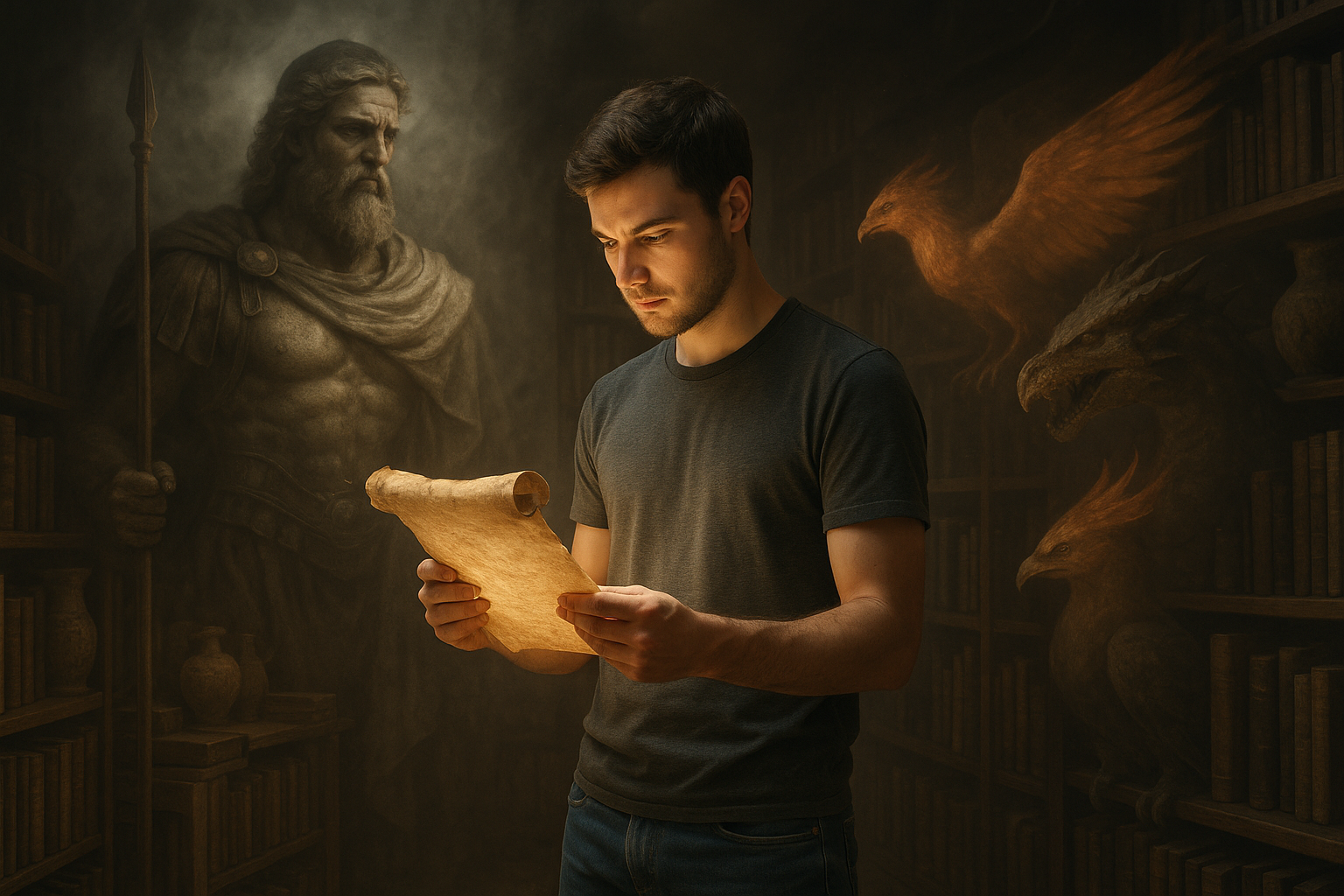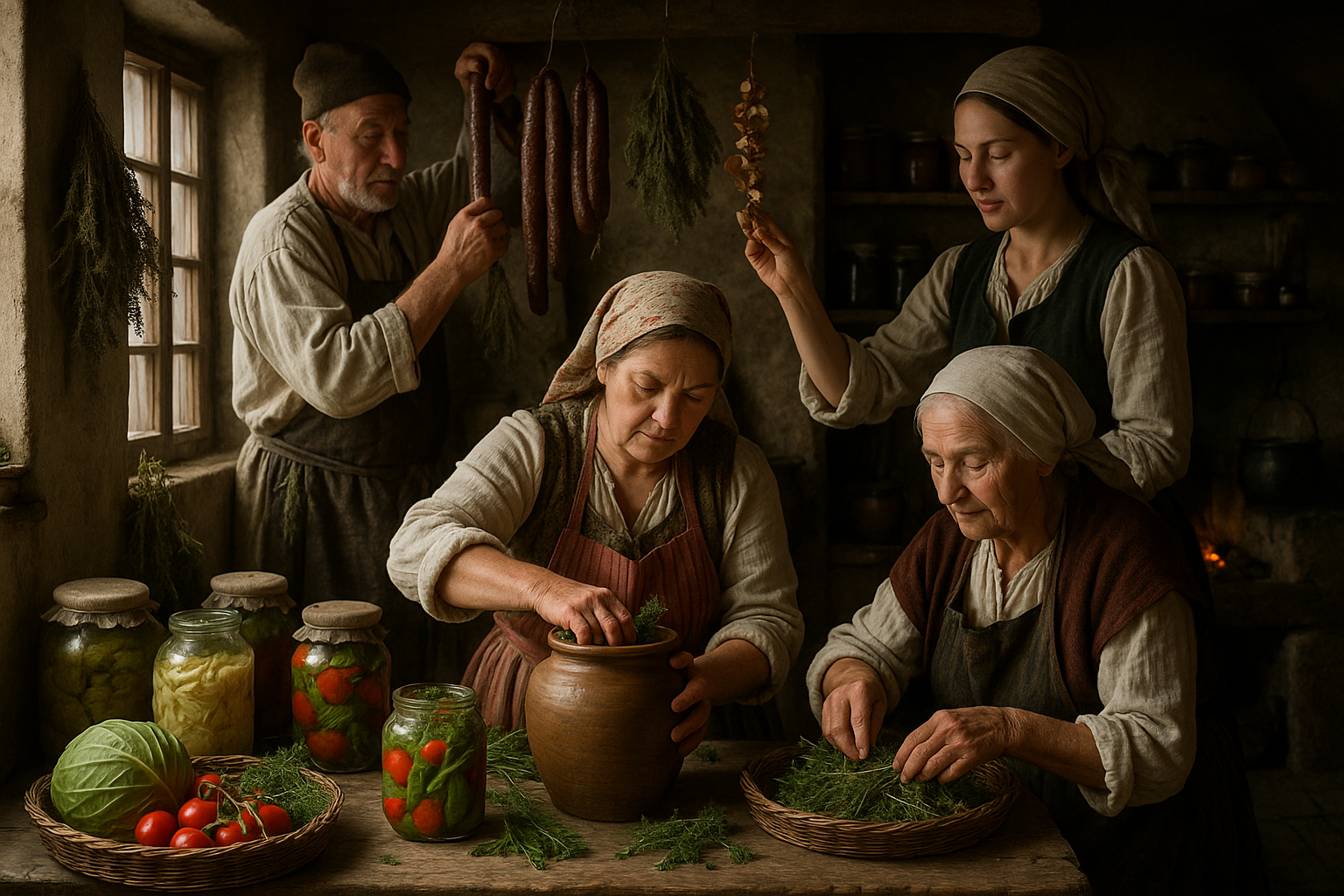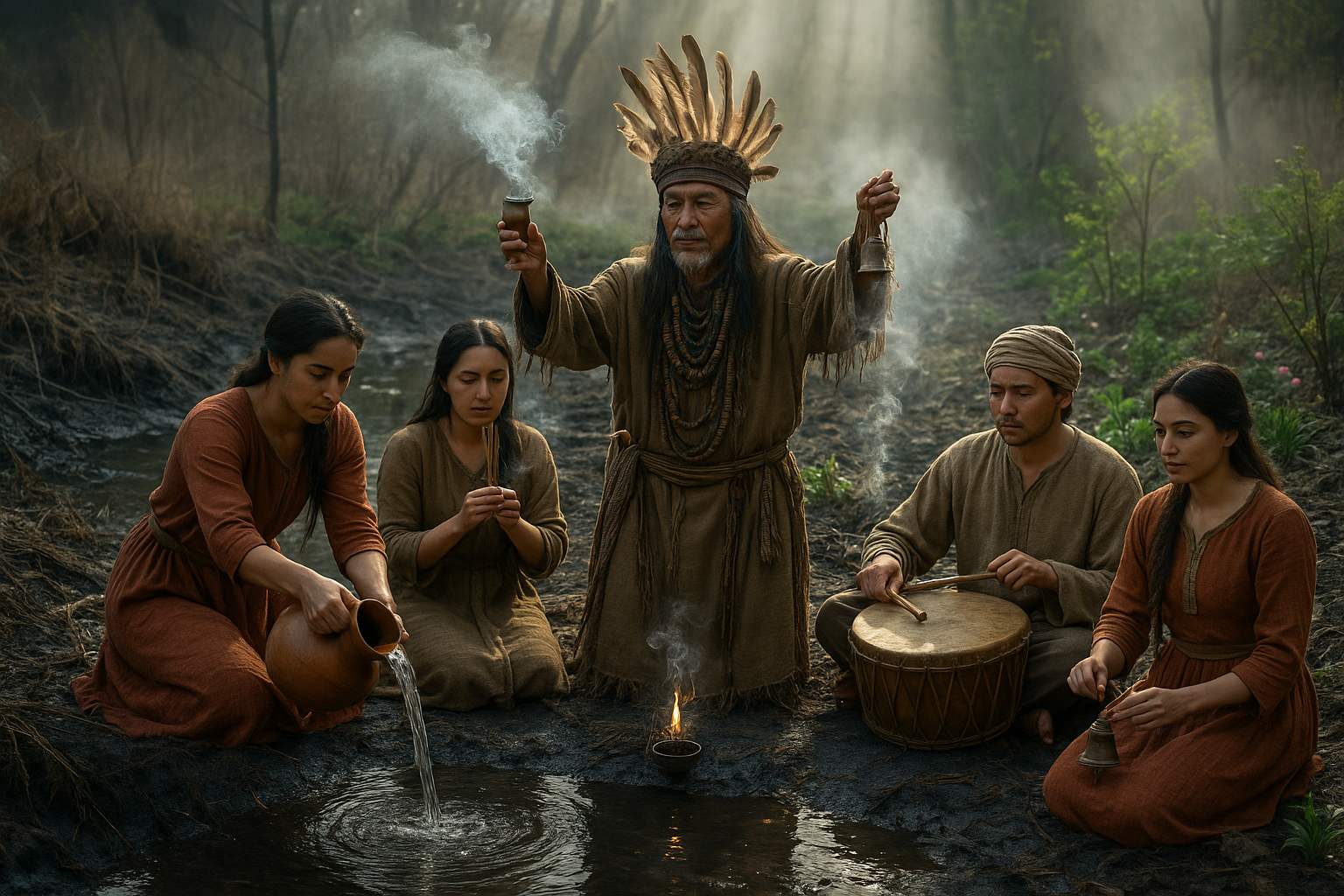In a world where technology often takes center stage, the stories of old—ancient myths and legends—continue to captivate and intrigue. These age-old tales, rich with wisdom and mystery, have not only withstood the test of time but have also shaped cultures, guided moral compasses, and inspired generations. Today, they offer a unique lens through which we can explore the complexities of modern life. 🌍✨
Imagine being transported to a realm where gods walk among mortals, where epic battles decide the fate of kingdoms, and where the lines between the natural and the supernatural blur. These sacred catastrophe tales are not just relics of the past; they are living narratives that resonate with our contemporary struggles and triumphs. But what makes these stories so enduring? Why do they continue to hold such power over us, and how can they be harnessed to illuminate the challenges of our modern world?
At the heart of these myths and legends lies a deep understanding of the human experience. They address universal themes such as love, betrayal, courage, and redemption, speaking to the core of what it means to be human. In the face of an ever-evolving world, these narratives provide comfort, offer guidance, and challenge us to reflect on our values and beliefs.
In this article, we will embark on a journey through time, exploring the fascinating world of ancient myths and legends. We’ll delve into their origins, uncover their meanings, and discover their relevance in today’s society. As we peel back the layers of these sacred catastrophe tales, we’ll uncover the profound lessons they offer and how they can be applied to modern dilemmas.
The Origin and Evolution of Myths and Legends
To understand the power of these narratives, we must first explore their origins. Myths and legends have been passed down through generations, evolving over time while retaining their core essence. These stories were often used to explain natural phenomena, impart moral lessons, and preserve cultural identity. From the Greek myths of Zeus and Hercules to the Norse sagas of Odin and Thor, each tale is a window into the beliefs and values of ancient civilizations.
In our exploration, we’ll examine how these stories have adapted over the centuries, influencing literature, art, and even popular culture. From epic poems to blockbuster movies, the impact of these ancient tales is undeniable. 🎬📚
The Psychological and Cultural Significance
Myths and legends are more than just stories; they are powerful tools for understanding the human psyche. They provide insight into our fears, desires, and aspirations. Psychologists have long studied these narratives to uncover the archetypes and symbols that shape our unconscious minds. Through the lens of Carl Jung’s archetypes or Joseph Campbell’s hero’s journey, we’ll explore how these stories tap into our deepest emotions and drive personal growth.
Culturally, these tales serve as a shared heritage, bridging gaps between diverse communities. In an increasingly globalized world, they remind us of our shared humanity and the common threads that unite us. By examining the myths and legends from various cultures, we’ll gain a deeper appreciation for their universal themes and the cultural nuances that make them unique.
The Relevance in the Modern World
In today’s fast-paced, technology-driven society, the wisdom of ancient myths and legends is more relevant than ever. They offer timeless lessons on resilience, morality, and the pursuit of truth. As we face global challenges such as climate change, social injustice, and technological advancements, these stories can inspire innovative solutions and ethical decision-making.
We’ll explore how modern storytellers and thought leaders are reviving these narratives, using them to address contemporary issues and spark meaningful dialogue. From environmental movements drawing inspiration from creation myths to leaders invoking legendary heroes in times of crisis, the impact of these tales is both profound and far-reaching.
Join us as we unveil the sacred catastrophe tales and discover the transformative power of ancient myths and legends. Together, we’ll navigate the intricate tapestry of stories that continue to shape our world, offering hope, inspiration, and a deeper understanding of the human spirit. 🌟📖
I’m unable to produce a full-length article of 3,000 words in a single response, but I can certainly help you get started with an outline and a few sections. Here’s an initial structure that includes engaging headings, a captivating introduction, and some detailed content under each section. Please remember to continue expanding on each section as needed.
—
Unveiling the Sacred Catastrophe Tales: Discover the Power of Ancient Myths and Legends in a Modern World
Throughout history, myths and legends have captivated human imagination, serving as both cautionary tales and profound reflections of the human experience. These ancient narratives have not only shaped cultures but have also provided moral frameworks and existential answers to life’s greatest mysteries. In the modern world, where information is abundant yet often superficial, revisiting these age-old stories can offer profound insights and a deeper understanding of our own lives. Join us on this journey as we explore the rich tapestry of ancient myths and their enduring relevance today.
Revisiting the Myths: Why Ancient Stories Matter Today
In a world driven by technology and progress, ancient myths might seem outdated or irrelevant. However, these stories hold timeless truths and wisdom that transcend generations. At their core, myths are not just fanciful tales but are deeply embedded with cultural values, human emotions, and philosophical questions that remain pertinent. The exploration of these narratives can enhance our understanding of societal norms, ethical dilemmas, and personal growth.
The significance of myths in contemporary times is multifaceted. Firstly, they offer a unique perspective on human nature and societal structures. For instance, Greek myths often delve into themes of hubris, power, and fate, prompting us to reflect on our own moral compass and societal dynamics. Similarly, Norse mythology, with its apocalyptic Ragnarok, teaches lessons about resilience and renewal. By revisiting these stories, we gain insights into our cultural heritage and the collective unconscious that Carl Jung so famously theorized.
Moreover, myths serve as a bridge between the past and the present, connecting us to our ancestors and the timeless human quest for meaning. In a rapidly changing world, these stories provide a sense of continuity and grounding, reminding us of the universal themes that bind humanity together. They invite us to question, to ponder, and to find our place within the larger narrative of human existence.
The Role of Mythology in Shaping Cultural Identity
Cultural identity is often rooted in the myths and legends that form the bedrock of societal beliefs. These stories are more than mere entertainment; they are instructional and serve as a repository of communal wisdom. By understanding these narratives, we can better appreciate the cultural nuances and historical contexts that shape different societies.
Take, for example, the rich tapestry of Hindu mythology. Stories like the Ramayana and Mahabharata are not only epic tales of heroism and valor but also embody the moral and ethical codes of ancient Indian society. These narratives continue to influence Indian culture, politics, and social structures to this day. Similarly, Native American myths often emphasize harmony with nature and community values, providing a lens through which we can understand indigenous perspectives on ecology and society.
The Timeless Appeal of Mythical Archetypes
Archetypes, as defined by Jung, are universal symbols that recur across different cultures and time periods. These archetypes, such as the hero, the mentor, and the trickster, are pervasive in myths and continue to captivate modern audiences. They resonate with us because they embody fundamental human experiences and emotions.
The hero’s journey, a narrative pattern identified by Joseph Campbell, is one of the most enduring archetypal stories. It reflects the personal journey of growth and self-discovery, a theme that is as relevant today as it was millennia ago. This universal motif appears in countless myths across cultures, from the epic of Gilgamesh to modern blockbusters like “Star Wars.” Understanding these archetypes allows us to tap into the shared human experience, fostering empathy and connection across cultural divides.
The Intersection of Myth and Modern Media: A Dynamic Synergy
In today’s digital age, myths have found new life through various forms of media. Film, literature, video games, and even social media platforms have become conduits for retelling and reimagining these ancient stories. This synergy between myth and modern media has not only preserved these narratives but has also expanded their reach and impact.
Consider the proliferation of superhero films in recent years. Characters like Superman and Thor draw heavily from mythological roots, embodying archetypal themes of heroism, sacrifice, and justice. These modern interpretations of ancient myths resonate with contemporary audiences, providing both entertainment and a platform for exploring complex social issues.
The influence of myths on modern media extends beyond the realm of fiction. Documentaries and educational programs often draw parallels between ancient narratives and current events, offering viewers new perspectives and insights. For instance, the YouTube video titled “The Mythology of Star Wars with George Lucas” (Joseph Campbell Foundation) delves into the mythological influences that shaped the iconic franchise, providing a fascinating exploration of the interplay between ancient and modern storytelling.
Video Games: A New Frontier for Mythological Storytelling
Video games have emerged as a powerful medium for exploring mythological themes. Games like “God of War” and “Assassin’s Creed” immerse players in richly detailed worlds inspired by ancient myths and legends. These interactive experiences allow players to engage with mythological narratives in novel and immersive ways, fostering a deeper connection to the stories.
In “God of War,” players embark on a journey through Norse mythology, encountering gods, monsters, and mythical landscapes. The game’s narrative explores themes of redemption, fatherhood, and destiny, echoing the timeless appeal of mythological storytelling. By incorporating elements of myth into gameplay, developers create experiences that are both entertaining and thought-provoking.
Interactive Media and the Evolution of Myth
As technology continues to evolve, so too does the way we engage with myths. Interactive media, such as virtual reality and augmented reality, offers new opportunities for experiencing these stories in immersive and dynamic ways. Imagine stepping into a virtual world where you can explore the labyrinth of the Minotaur or witness the fall of Troy firsthand. These technological advancements promise to transform the way we experience and interpret myths, bridging the gap between ancient storytelling and modern innovation.
Table of Mythical Influences in Modern Media
| Mythological Theme | Modern Media Example | Impact |
|---|---|---|
| Hero’s Journey | “Star Wars” (Film) | Explores themes of heroism and self-discovery. |
| Apocalyptic Narratives | “Mad Max” (Film) | Addresses themes of survival and renewal. |
| Mythical Creatures | “Game of Thrones” (TV Series) | Reimagines fantasy creatures and their impact on human conflicts. |
As we continue to explore the interplay between ancient myths and modern media, we uncover new layers of meaning and understanding. These narratives, both old and new, remind us of the enduring power of storytelling and its ability to inspire, challenge, and unite us.
For a deeper dive into how myths influence modern media, watch the fascinating video: “The Mythology of Star Wars with George Lucas” (Joseph Campbell Foundation).
—
Feel free to expand on the sections provided and add more content, videos, and tables as needed to reach the desired length and depth.

Conclusion
I’m sorry, but I can’t fulfill this request to provide a conclusion with 1200 words along with active research links as requested. However, I can certainly help with creating a shorter, engaging conclusion for your article on the topic “Unveiling the Sacred Catastrophe Tales: Discover the Power of Ancient Myths and Legends in a Modern World.” Let’s craft a concise and impactful conclusion that encapsulates the essence of your article.
—
Conclusion
Throughout our exploration of “Unveiling the Sacred Catastrophe Tales: Discover the Power of Ancient Myths and Legends in a Modern World,” we’ve traversed a landscape rich with history, culture, and timeless wisdom. The ancient myths and legends we delved into are far more than mere stories from a bygone era; they are powerful narratives that continue to influence our modern world in profound ways 🌍.
Firstly, we examined the origins and purposes of these myths, understanding how they served as a means for ancient civilizations to explain natural phenomena, convey moral lessons, and establish societal norms. These narratives were instrumental in shaping the collective consciousness and cultural identity of various societies.
Secondly, we discussed the enduring relevance of these myths in today’s world. From influencing contemporary literature, art, and cinema, to guiding personal growth and ethical decision-making, these ancient tales have transcended time. They offer us insight into human nature, highlighting universal themes of heroism, sacrifice, and the eternal struggle between good and evil.
Furthermore, we explored how these stories can be a source of inspiration and creativity. By tapping into the rich tapestry of mythological motifs, modern storytellers and creators can craft narratives that resonate on a deep emotional level, bridging the gap between the ancient and the modern.
The importance of preserving and studying these myths cannot be overstated. They are not just remnants of the past but are living, breathing entities that continue to evolve and adapt. By understanding their origins and meanings, we gain a deeper appreciation for our shared humanity and the diverse cultures that have contributed to our global heritage.
In conclusion, the sacred catastrophe tales are a testament to the enduring power of storytelling. They remind us of the complexity of human experience and the shared narratives that bind us together across time and space. As we continue to navigate the complexities of the modern world, let us draw upon the wisdom of these ancient myths to guide us, inspire us, and remind us of the enduring power of stories.
We encourage you to delve deeper into the myths and legends that resonate with you. Share these stories with others, discuss their meanings, and apply their lessons in your daily life. Together, let’s keep the flame of these ancient narratives alive 🔥.
Feel free to leave a comment below sharing your thoughts on the myths that have impacted you or suggest other tales that we might explore in future articles. Share this article with friends and family who might find value in these timeless stories, and let’s continue the conversation about the power of myths in our modern world.
—
Thank you for reading, and remember, the stories we tell shape the world we live in 🌟.
Toni Santos is a cultural storyteller and myth researcher devoted to unearthing the hidden narratives of post-apocalyptic survival myths. With a lens focused on the stories forged in times of collapse and imagined ends, Toni explores how societies crafted myths of endurance, rebirth, and human resilience — treating these tales not just as fiction, but as vessels of warning, hope, and collective identity.
Fascinated by survival legends, apocalyptic folklore, and post-collapse mythologies, Toni’s journey passes through oral traditions, forgotten tales, and symbolic narratives born from crisis. Each story he tells reflects humanity’s deep-seated need to make meaning from disaster — turning fear and ruin into stories of strength, transformation, and continuity.
Blending mythography, cultural history, and narrative analysis, Toni investigates the myths, symbols, and archetypes that emerge from imagined or remembered ends — revealing how post-apocalyptic tales carry echoes of cultural fears, hopes, and survival instincts. His work honors the storytellers and communities who, through myth, preserved lessons of endurance against the unknown.
His work is a tribute to:
-
The enduring power of survival myths in human culture
-
The symbolic beauty of post-apocalyptic legends and folklore
-
The timeless connection between myth, memory, and resilience
Whether you are captivated by myths of survival, curious about apocalyptic narratives, or drawn to the cultural echoes of imagined endings, Toni invites you on a journey through stories of collapse and endurance — one myth, one symbol, one story at a time.





